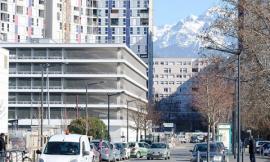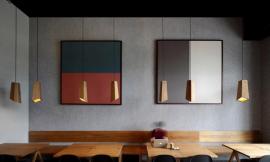来自ENOTA的分享。
激活城市活力,将看似对立的“更多的绿色”与“更多的表演空间”完美结合。
Promenada工程位于斯洛文尼亚一个建于1950年代的年轻小镇Velenje。处于城镇中心的项目旨在通过提供当地缺少的城市公共空间来激活城市活力,提供空间之外的更大包容力,并将两个看似矛盾的对立面“更多的绿色”与“更多的表演空间”完美结合。
视频:河流剧场Link to Promenada - river amphitheatre video:https://vimeo.com/104689171Credits: Video is filmed & edited by Miran Kambi?
视频:花园道路Link to Promenada – walk through video:https://vimeo.com/114213241Credits: Video is filmed & edited by Miran Kambi?

↑ 河边剧场 river amphitheatre

↑ 步行道 walking path
PROMENADA
The Velenje "Promenada" is an important city space and a vital city thoroughfare. It is one of the key axes of the city centre, which is why it cannot be considered separately from the other city space within the context of the planned renovation. The intervention into the space must naturally be designed locally, in a way that allows an execution in stages, as provisioned in the project's budget. Still, it makes sense to outline the vision of the revitalization of the entire city centre; in this way, the spatial intervention is given a wider framework, which will ensure an informed sitting into the present and future city space.

↑ 过去 before

↑ 改造前后平面plan (before vs after)

↑ 改造后 after

↑ 改造后 after
全方位改造只为吸引人前往---城市振兴的关键在于人,只有人被吸引入城市才会让城市充满活力。
Velenje兴建于二次世界大战以后,采用现代园林城市理念作为指导,算得上是斯诺文尼亚该国的一个特别小镇。但随着时代的发展,城镇必须升级,需要打通封闭的交通模式,为更多的人服务,提供更多的公共空间。
城市振兴的关键在于人,如果不能吸引人注入城市,给城市带来活力,那么一切的振兴都是纸上谈兵。建筑师把城市用户分为两大类,一类是已经居住在城市中的活跃用户,但是他们为了获得更大的居住面积和更好的环境已经搬到郊区的独栋住宅。为了吸引用户回来需要在城镇中提供全新的多层次公寓,这些公寓应该光线充足,通风良好,还要有美丽的绿色露台。另外一类人是前往城市办事或者参加活动的人---对这类人群,便需要提供一个良好的活动发生地并支持活动连续发生,当人们习惯于到城镇来之后,商业便能发展,整个城市也随之繁荣。

↑ 城市中心演变分析 city center diagrams

↑ 主要干涉领域 main programmatic areas

↑ 改造理念概要 proposed shematic interventions

↑ 改造理念概要 proposed shematic interventions
Full-scale renovation of the city centre
Velenje is a special city. As new post-war town, its design was based on the Modernist ideal of the garden city and as such, it is unique in the Slovene space. This special characteristic is to be, first of all, retained; it is then to be rid of unnecessary and undesirable elements that have accrued through time; finally, it needs to be upgraded according to the needs of contemporary life. The city centre must be enhanced with the programmes it is missing, instilling more life into it. We have every possibility to accomplish this: the city centre is closed for traffic, which comparable cities are yet to achieve; and the city's airy design offers sufficient available surfaces to accommodate additional programme.
What, then, is needed for the city centre to be revitalized? People! Only people as active users of the space can infuse the city with the energy necessary for its rebirth. And how to go about bringing more people into the city?
The users of the city centre may be placed roughly into two groups. Those in the first group live in the city; they are the most active users of the space, but there are relatively few of them living in the city centre nowadays. Additional inhabitants must be attracted with greater quality of habitation. New types of flats with multi-leveled, well-lit and airy spaces and green terraces could win over particularly those young families who would otherwise fulfill their housing needs by moving to a single-family house on the outskirts of the town. In doing that, the settlement structure of the city centre is improved and new users of the space are secured. Not insignificantly, such a form of habitation is also much more sustainable than individual residential development in the city's surrounding areas.

Other users arrive into the city, some by bicycle or using public transport. These two forms of access must naturally be encouraged but one needs to realize that due to the relatively small size of the town, it's impossible for the public transport in particular to be fully developed. Due to the town's dispersion, many arrive into the city centre by car, and already today, a large portion of the city's surface is designated for stationary traffic. If the number of visitors to the city centre is to be increased, this is a problem that needs to be solved.
But why do people choose to come to town for? Mainly for the programme and events. To revitalize the city, all the events (of which there is no shortage in Velenje) need to be purposely concentrated in the centre so as to generate the necessary critical mass and continuity of activity. People simply have to get used to coming to the city. The commercial programme will then automatically follow the demand and further enrich the activity in the city centre. Having the necessary infrastructure in place is certainly helpful, though.


全新的空间+河流剧场
原来宽大但是乏味,仅仅被用作通行的城市道路被重新改造,被赋予相当丰富的内容,首先路径变得曲折有趣,有缩有放,其次利用精美比例的混凝土台制造出众多可以休憩与停留的空间。然后,道路在遇见河道的地方,两者相互碰撞变成一个滨河戏水休闲景观带+滨河剧场。河流虽然湍急,但水位在一年中大部分时间是稳定的,建筑师通过灵活的阶梯式空间适应河流,营造出精彩空间。临河段也成为这个城镇最耀眼的明珠。


Promenada
The existing promenade was created by closing the erstwhile traffic road almost thirty years ago. Even though it was re-paved, a sufficiently thorough transformation never took place and the promenade has retained the character of a road, remaining too wide and rather dull due to the lack of content. It has been a kind of hybrid space between the road and the surface intended for pedestrians - chiefly a straight path quickly leading the users of the secondary-school complex and the community health centre to the inner centre without providing any animation for those out for a walk.
Through renovation, the wide straight connection with a clearly delineated beginning and termination underwent a transformation into a kind of sequence of micro-ambients, of locally widened surfaces connected by a slightly twisting narrower path. These instances of widening (in effect squares) feature attractive concrete urban elements (benches) whose careful arrangement slows down the users and provides focus, framing the space for the additional programme content to take place. As the path locally twists along the surrounding buildings, it gives rise to larger contained open spaces, allowing future expansion of the content from the buildings outwards, or the accommodation of other additional content as required over time. In the initial phase, all these newly-formed public spaces are simply and cost-effectively laid out as sand or grass surfaces, with sand surfaces in particular representing a successful middle ground between grass and paved city spaces and allowing a wide range of use with only modest investment.






With the transformation, the Promenada is turning into a main event axis of the city, its centre being placed into the new amphitheatre along the river. The river Paka is a torrential river, which means that its watercourse swells up significantly a few times a year, but remains relatively shallow at all other times. As a consequence, the riverbed is very deep and until now, the river, which is an attractive element of any city, flowed out of sight somewhere down below. The wide bridge also meant that anyone walking across it had a hard time seeing the river at all. By narrowing the bridge and placing it off the former axis, the space for the construction of an amphitheatre, which slowly slopes down towards the river surface, is recovered. The attractive amphitheatre by the river, with the new bridge serving as its backdrop, becomes the centre of the activity in the city, and the river may once again claim an important spot in the townspeople's consciousness.







公园式步行区
The ParkAt present, the area of the park is on the northern bank of the Paka, enclosed by the river on one side and by the delivery road to the school complex on the other. The visitors to the park don't have a real contact with the river, as the torrential canal of the Paka is liberally overgrown with vegetation. The southern bank of the river serves as a public car park. In accordance with the projection of removing the traffic and parking surfaces from the inner city centre, the green area of the park is to be extended across both banks of the Paka, all the way from the school complex buildings on one side and the Cultural center and the former coal-mine administration building on the other. Paka's relatively deep riverbed now divides the area into half, but by modifying the riverfronts and creating a stepped approach towards the water level, it becomes the area's central element. In several places and on several levels, both riverfronts are connected into a unified whole. Footbridges extend into the network of paths on either bank, terminating at the existing passages between the buildings. So as to achieve better integration into the unified design of the park, the existing delivery and emergency routes are slightly modified. In combination with some of the rigid surfaces, they retain their function to a large extent yet visually, they are subsumed into the network of footpaths.








增加高容量的地下停车场
作为花园城市的Velenje虽然有很多绿地,但如果这些绿地被停车场腐蚀,将会降低环境品质,为此设计师为城镇保留必须的应急路面停车场之外,还设计了一个高容量的停车场。关于这个停车场,我们曾经报道过,详情请点击韦莱涅地下停车场。
Parking ( More About Velenje Car Park)
Velenje was designed as a garden city and as such, it had a lot of unoccupied ground-level surfaces. With the increase in the number of vehicles, these surfaces began to turn into car parks. Despite the fact that Velenje's centre is a pedestrian zone, a large - possibly too large - portion of the exterior ground surface is designated for stationary traffic. This also crucially affects the quality of open-air habitation. And with the envisioned increase in the number of users of the city centre, car parks stand to become an even bigger problem. For a successful revitalization, solutions need to be found which will increase the number of available parking spaces while reducing the surface area occupied by them at present.
Parking surfaces may be divided into two groups. The first are the residents' parking spaces; due to private ownership, little can be done about those. The surfaces occupied by public car parks, however, need to be rationalized by multi-leveled parking. Such parking arrangements are to be sited along the perimeter road and placed at the beginnings of the main walking directions. This way, they're easily accessible by vehicles and pedestrians alike. Parking and exiting must be uncomplicated, removed by no more than one floor from the street level. There is greenery all around the car park, and it hosts a commercial programme made attractive due to a high frequency of visitors.
Additional car parks (via underground parking garages) may also be secured in places intended for new residential development. Careful spatial policy encouraging the construction of additional parking spaces beside those intended for the new flats could lead to the reduction of the existing privately-owned parking surfaces. If swapping an open-air parking space for a place in an underground parking garage were made compelling enough, the ground-level parking surfaces could be reduced to only emergency parking, temporary parking spaces, and deliveries.
project Velenje City Center Pedestrian Zone Promenadatype open competition, first prizeyear 2012status completed 2014
size 17.020 m2budget 2.700.000 EURclient Velenje Municipalitylocation Velenje, Slovenia
architecture ENOTAproject team Dean Lah, Milan Tomac, Tja? Bauer, Andrej Oblak, Polona Rupar?i?, Nu?a Zavr?nik ?ilec, Alja ?erne, Neboj?a Vertov?ek
structural engineering Elea iCstructural engineering Nom biroelectrical planning Elsing
photo Miran Kambi?
MORE: ENOTA
via:gooood.hk |
|

 TRIVOC PATISSERIES & CAFE / Drawing Architecture Studio
TRIVOC PATISSERIES & CAFE / Drawing Architecture Studio
